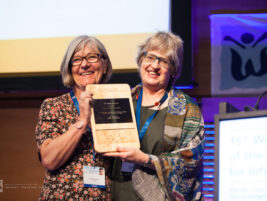Despite the potential of infant-parent psychotherapy to modify distorted projections and reset skewed developmental trajectories, early childhood mental health therapists frequently find ourselves in situations where such change is unlikely despite our best efforts. “ At times, we find ourselves working with children whom nobody wants or even sees, and with parents whose capacities for attachment are mortally wounded, in communities with few if any appropriate services for the families of infants,” (p. 8) writes Marion Birch in her introduction to this extraordinary book, an exploration of six treatments that were “ heartbreaking failures.”
Tackling the taboo of clinical failures, naming the odds against success for many at-risk families, this is an important book for clinicians working with families of very young children. Experienced therapists will appreciate the complexities tackled by the authors, while new therapists will benefit from the book’s realistic assessment of difficulties as well as its demonstrations of clinical self-awareness at its best.
Six clinicians each write a chapter about their work with, and feelings about, a family they tried to help with disappointing outcomes. Susan Sklan’s work with a 16-year-old mother had a promising beginning; the mother asked for therapy while pregnant. But Sklan’s and mother’s good intentions were not enough in the face of the mother’s history of unresolved trauma, the instability of her living situations and Sklan’s professional isolation.
Marion Birch worked for four years with Ben, a two-year-old boy who, after a sadistically deprived infancy, was lucky to have sensitive, caring adoptive parents. Many clinicians will resonate with Birch’s response to Ben’s incessantly aggressive play scenarios, “ grafting themes of rescue and comfort onto his dramas.” (p. 89)Ultimately, however, Ben did not adjust to his new home. Birch wonders whether she, as well as Ben’s parents, lacked “ the courage or wisdom to go with Ben into that terror-filled world he came from.” (p. 94)If she had gone there, could the outcome have been different for this family?
Richard Ruth describes the vicissitudes of a White therapist working with a Black family whose children are in foster care. For Julie Stone, a mother’s projections onto her child lead to the question: “ Do we, and did I, flinch from thinking about hate because I was afraid of my own hate and destructive potential?” (p. 171)Martin Maldonado-Duran’s work invites thinking about cultural clashes between the expectations of family members and the therapist. Toni Vaughn Heineman
faces her sense of responsibility for a child in the foster care system who has no one caring for her. Heineman writes, “ When we are confronted with the vacuum of maternal care that engulfs children in foster care it surely stirs a primitive panic in us.” (p. 242)
These brief introductions may convey some of the range of this remarkable volume—the variety of clinical challenges and the integrity with which the contributors examine their work and their feelings about the work. Each chapter is followed by a reflection written by another contributor to the book, adding additional layers of understanding to the complex dilemmas of the treatment. In her masterful concluding chapter, the editor, Marian Birch, extracts eight “ threads” that run through the cases and explores the impact of these issues on the six therapies.The thoughtful reflections, first by the clinician, then by the colleague offering commentary and finally by the editor, implicitly invite the readers to think deeply about our own work and to share our reflections with ourcolleagues.
It may seem paradoxical that a book about well-intentioned and experienced therapists doing hard work with disappointing outcomes is ultimately encouraging rather than disheartening. In part, this is because of the relief at having our challenges named and assessed for what they are. Just as our clients may feelsupported by empathic identification of their troubles, we are strengthened by the acknowledgement of the difficulties we face.
Finding hope in despair is also reassuring because of its perspective that countertransference reactions are inevitable. As Birch points out, “ [t]he emotional responses that we as therapist have, when we are exposed to infants in states of activated attachment need, are rooted in our biology and our personal history.” (p. 5) The authors in this volume model ruthless honesty in theirexploration of their responses, demonstrating how countertransference, when acknowledged, can point to new directions in our work.
The impact of countertransference is only one of many elements that canundermine therapy, including systemic and institutional forces beyond our control, and including the severe disorganization of some of the families we see. A theme in this book is the limitation of a strengths-based approach. In many of these chapters the therapists acknowledge the disservice to their clients of underestimating the depth of their trauma, hatred or internal chaos. An important corollary is the disservice to therapists when we have unrealistic expectations of what is possible for us to do to support a family to change.
Finding hope in despair examines six times when the combination of risk factors in the family, limitations on the therapist and scarcity of social supports lead to therapy with painfully disappointing outcomes. It is both an analysis of the difficulty of therapeutic efforts in such conditions and an example of how reflection leads to understandings that can change future practice. An extremely rich volume that will bear many re-readings, Finding Hope in Despair should be in the library of all therapists providing parent-child therapy to at-risk families—and in the curriculum of all training programs for this work.
Book Review:Finding hope in despair: Clinical studies in infant mental health
Authors
Edited by Birch, Marian,
Zero to Three, Washington D.C., 2008
Reviewed by Rossoff, Margaret,
USA








